Could Be Artful. A Most Important Aspect of Local Building Regulations, and LEED Criteria – Part I
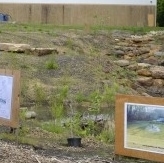
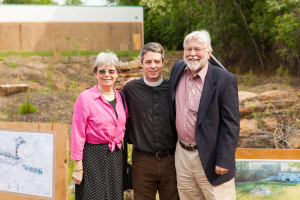
For me, personally/professionally, for your Formation Building and for advocates of Bay restoration actions, stormwater management is one of the most important, involved and rewarding aspects of support for sustainable eco systems. Cost, of course, is another aspect of it. Big Cost–for prior abuse.
In the local paper recently was an article about a $1 million stream restoration just begun, the Cabin Branch Project near the Annapolis Mall (funding: the Chesapeake Bay Trust, the National Fish and Wildlife Foundation and both the Maryland DNR and MDE). The restoration will be the responsibility of the Severn River Federation and its Riverkeeper, Fred Kelly–parishioner Nancy Kelly’s husband. As of now, future projects will be undertaken by Anne Arundel County, funded by the newly enacted stormwater management/”rain” tax state-mandated for our county and 9 others.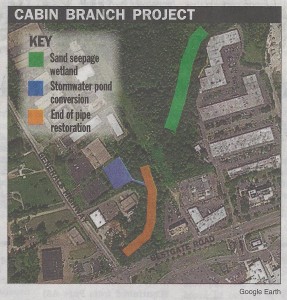
The stream beds proposed for restoration have suffered major damage from stormwater runoff emanating from the Mall and the paved infrastructure surrounding it from Generals Highway and Bestgate Road. Imagine the acres of imprevious surface and what’s washed into the nearby streambeds? I’m imagining water laced with toluene and other petroleum byproducts, oil-stained hubcaps, all of the Top 10 U.S. litter items and a very big measure of other nondegradable waste on any given rainy day–especially like yesterday’s!
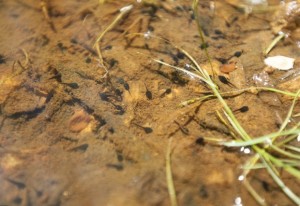

Three techniques will be used to “slow, cool and clean [the] stormwater” in the Cabin Branch project. These are stormwater pipe restoration, stormwater pond conversion and sand seepage wetland.
“The first creates a series of step pools to slow the rush of stormwater as it moves from one pool to another. The second will turn old stormwater ponds [out-of-favor these days for stormwater management], which were meant only to hold back the volume from large storms, into structures that will absorb some pollutant nutrients and sediment before water moves downstream.”
And, “The third imitates the nutrient and sediment absorbing nature of the pre-development landscape.”
Chris Phipps, of the County DPW, said: “We will be able to count the nutrient and sediment reductions from those projects toward our pollution diet goals.” Pollution diet goals? Were you aware?
According to its website, the US EPA “established at the close of 2010 the Chesapeake Bay Total Maximum Daily Load (TMDL), a historic and comprehensive ‘pollution diet’ [reduction of nitrogen, phosphorus and sediment] with rigorous accountability measures to initiate sweeping [my emphasis] actions to restore clean water in the Chesapeake Bay and the region’s streams, creeks and rivers.” Per the underlying Clean Water Act, all waters in the U. S. are to be “swimmable” and “fishable” by 2025. The TMDL is imposed on so-called “impaired waterways,” such as the Bay and its tidal tributaries.
To review the article in its entirety, click here.
This TMDL standard is intended to countermand the suffocation of the Chesapeake Bay over decades by discharge or runoff from wastewater treatment plant overflows, corporate-scaled animal feeding operations, on-site septic systems, stormwater ineffectively treated or not, and air pollution. Shouldn’t we be fully engaged in environmental stewardship at a cost sufficient enough to restore our habitat? OBTW, did you read my 2/28 post—“River Gardens to Help Restore the Magothy”? (click here)
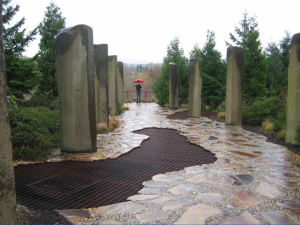 Recently, I went to the LEED Gold Miller Library in Ellicott City for a presentation by two Penn State professors called “Artful Rainwater Design.” See, stormwater is out. Rainwater is in! Anyway, the place was packed with landscape architects, green building types and just plain folk. If, like me, you don’t get enough art in your life, go to their website here if you’re interested in seeing a new kind of art in public places (nee site amenities).
Recently, I went to the LEED Gold Miller Library in Ellicott City for a presentation by two Penn State professors called “Artful Rainwater Design.” See, stormwater is out. Rainwater is in! Anyway, the place was packed with landscape architects, green building types and just plain folk. If, like me, you don’t get enough art in your life, go to their website here if you’re interested in seeing a new kind of art in public places (nee site amenities).
Part II will sketch the stormwater quantity and quality design for St. Margaret’s proposed Formation Building. Please–as artful rainwater design is expensive, don’t expect it south of the new building. The scale of our project in terms of “rainwater management” is relatively small but nonetheless an opportunity to do a better job.